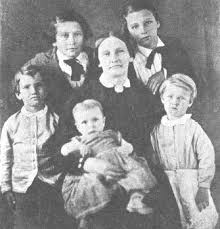| Mary Maverick, pioneer and diarist, whose published memoirs chronicle her pioneer experiences in Texas, was born on March 16, 1818, in Tuscaloosa County, Alabama, the daughter of William Lewis and Agatha Strother Adams. Adams was a lawyer. Mary grew up on the family plantation three miles north of Tuscaloosa, where she received schooling. On August 4, 1836, at her home, she married Samuel Augustus Maverick, who had participated in the Texas Revolution. After extended visits to relatives in Alabama and South Carolina, the couple moved to Texas at the beginning of 1838.
The Mavericks searched for years for a permanent home along the unsettled Texas frontier. They located first in San Antonio, where Sam wished to spend his time speculating in West Texas land; then, during the Runaway of ’42, an exodus of families from San Antonio at the news of approaching Mexican soldiers under Adrián Woll, they set up a home on the Colorado River near Gonzales. They moved to Decrows (Decros) Point on Matagorda Bay in 1844 and remained there until October 1847, when they returned to San Antonio. Most of Mary Maverick’s energies during these early years in Texas went into the raising of her family. She bore ten children in twenty-one years; four died of illness before they reached the age of eight, leading their mother to seek solace in the spiritualism and alternative medical treatment so popular in mid-nineteenth-century America. As her surviving children grew up, she became increasingly active in the public sphere. During the Civil War, when she had four sons in the Confederate Army, she was active in San Antonio relief efforts. She also devoted much of her time to church work. A devout Episcopalian, she was instrumental in establishing and developing St. Mark’s Church in San Antonio and served as president of the Ladies’ Parish Aid Society for over twenty years.
After her husband’s death in 1870, as San Antonio grew and thrived, Mary Maverick made efforts to see that the pioneer past was not forgotten. She was a prominent member of the San Antonio Historical Society and the Daughters of the Republic of Texas. She helped promote the annual Battle of Flowers celebration, and she served as president of the Alamo Monument Association for many years, during which she kept before the public the need for restoration of the historic site. Her watercolor sketch of the mission, completed during her first residence in San Antonio, is often referred to by historians, and in 1889 she wrote a brief account of the fall of the Alamo.
Mary had kept diaries of her frontier experiences, and in 1880 she shaped them into memoirs. Fifteen years later, with the help of her son George Madison Maverick, she published a limited number of copies. The memoirs have since been reprinted and provide a vivid picture of life on the Texas frontier. Mary Maverick’s work, particularly her eyewitness account of the Council House Fight in San Antonio in 1840, has often been cited in studies of Texas pioneer life. She died on February 24, 1898, and was buried in City Cemetery No. 1, San Antonio. |















